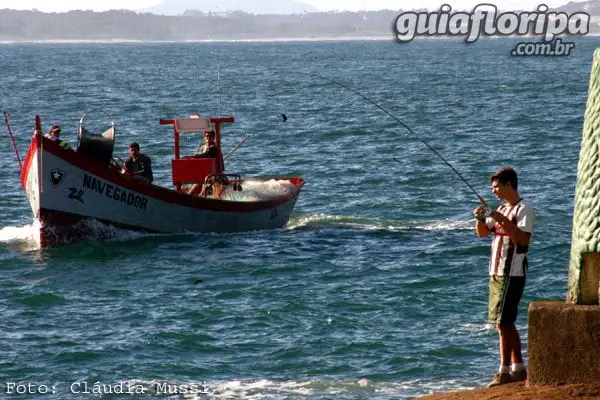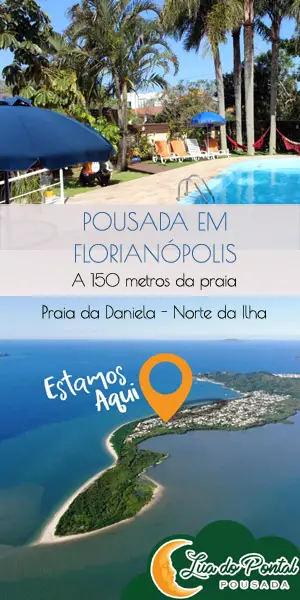Beach fishing in Florianópolis is quite common, being practiced on long beaches, such as the Campeche e Mozambique, but also on the beaches of the North and South Bays, such as Beira-mar Norte and Ribeirao da Ilha, beaches where there are several places for throwing and little presence of bathers. Fishing is also highlighted by the practicality and low cost of equipment.

what do you need
To practice the sport, in addition to the rod and the reel, the fisherman cannot fail to acquire some basic items, however, of paramount importance for any surprises. Items such as pellets, lines, hooks, scissors, knife, trill, whips, hook puller, sunscreen, hat, raincoat and Ibama fishing license are essential to carry out the activity.
ADVERTISING
where to fish
In just one beach we can have several types of places for fishing, with different depths named Shallow Beaches, Tombo Beaches, Beach Channels and Lagamars. Check out the description and tips for finding fish in each of them below:
Shallow beaches: Shallow beaches are characterized by having a depth that gradually increases and that presents a series of waves, generated by channels and a series of calm waves, which also attract bathers. In this type of beach, the fish are a little further from the shore, having to use quality equipment to perform long casts and find the fish. Another option is to enter the water up to your knees and launch to achieve greater distance, however, for this type of fishing it is important to be aware of the restrictions and warnings of the lifeguards. For this type of beach, we found two great baits that are very attractive to fish, the cork and the beach worm. Examples of Shallow Beaches on the Island: Ponta das Canas, Jurerê, Daniela, Ribeirao da Ilha, Saint Anthony of Lisbon, Barra da Lagoa, Canasvieiras, among others.

Tombo beaches: The tumble beaches are those where the depth is great, which increases quickly right on its edge, presenting visible channels and a sequence of strong waves. With this, the fisherman gains an advantage to perform the cast, and in this case, he doesn't even need to get wet to launch his bait. On tumble beaches, fishermen can find fish right in the first channel, especially fish that like depth. In this case, large fish such as sea bass are less than 10 meters from the sand, while in the range of 40 to 80 meters we find large croakers and dogfish, among others. Examples of Tombo Beaches on the Island: Campeche, Cruet, Mozambique, Morro das Pedras, soft beach, among others.
Beach channels: We were able to identify such channels, observing the moment when the waves form, gaining volume. This indicates that down there there is a channel, ditch or hole, where the fish pass to feed, usually in shoals.
On the shallow beach we have several shallower channels and on the tombo beach we find 3 to 4 deeper channels. To look for the fish it is important to alternate the castings between the channels, and depending on the day, the fish can be in the first channel as well as in the second or last, so it is essential to observe where we have more action. In addition, to fish in these channels it is ideal to choose a lead with pyramids or with claws, of at least 120 grams, to be able to fix the baits inside the channels, otherwise, in a short time they will be in the sand.
ADVERTISING
Lagamars: Lagamars are formed when water from several waves, which reached the beach, ends up coming together at the same point of return to the sea. In this place, the force of the water drags everything that is in the way, including the sand, forming large holes, up to 1,70 meters deep. In these holes, large wells shelter the fish that look for food, and they are often hidden there. However, in these places it is important to be aware, because the lagares are quite dangerous because they cause many deaths by drowning. The Lagamares are present in the open sea beaches, of great depth as in Praia do Campeche, Mozambique, Morro das Pedras, saint, among others.
baits
The most suitable baits for each specimen found on the beaches of the Island:
Anchovy: Corrupt and Manjuba;
Whiting: Live shrimp;
Burriquet: Corrupt;
croaker: Shrimp, Corrupt, Fish, Cocoon Tail;
Sword: Manjuba;
Grouper: Bonito and Manjuba;
Pampo: Tatuira and Corrupt;
Hake: Manjuba;
Sea bass: Corrupt, live or dead shrimp, fillet of Manjuba or Carapicú;
bream: Tattoo.
See also: Boat trip with Recreational Fishing in Florianópolis.
Decathlon Florianopolis
Decathlon Florianopolis | Sporting Goods in Florianópolis.




